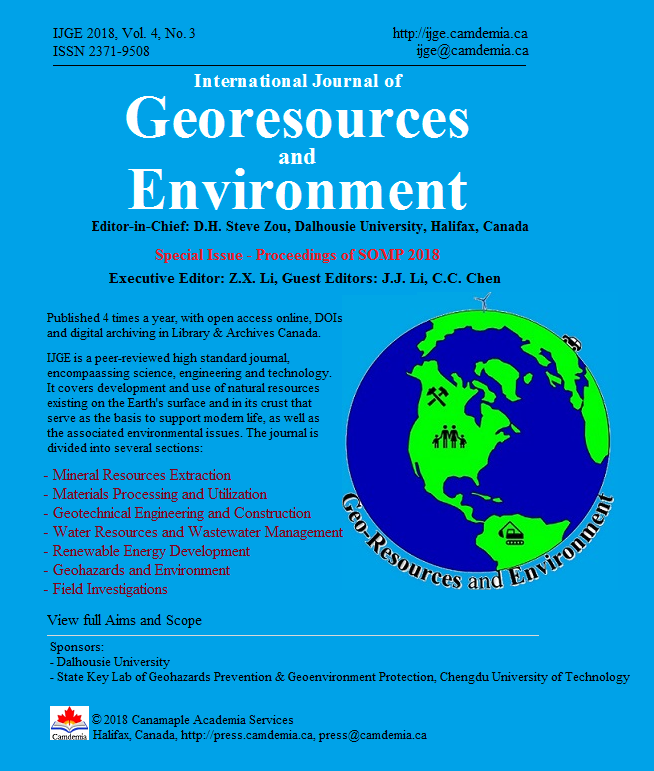Application of Aeromagnetic, Remote Sensing and Geological Data in the Delineation of the Geological Structures
DOI:
https://doi.org/10.15273/ijge.2018.03.023Keywords:
aeromagnetic, remote sensing, geological data, geological structures, hot springs, faultsAbstract
Siloam village is well known for its hot springs that geologically lie in the Nzhelele Formation of the Soutpansberg Group rocks. About 1800 million years ago, the Soutpansberg depositional basin was formed as an east-west trending asymmetrical rift. These Soutpansberg group rocks were severely faulted which resulted in a number of major faults, like the Siloam fault. Faults provide channels through which the hydrothermal fluids can flow. These fluids are heat sources for the hot springs. With no evidence of recent volcanic activities in the Limpopo province, it is assumed that all the hot springs are of meteoric origin and the heating of the hot springs is due to the deep circulation along fault zones. The main objective of the study is to delineate the faults that are potential recharge zones of the hot springs above the ground at Siloam village using remote sensing, geological maps and aeromagnetic data. LANDSAT 8 (OLI, November 2015), scenes P69, R76 (path 69 and row 76) free of cloud cover were downloaded from the USGS website page. The data was reduced to remove excess noise. A number of processing techniques were done to further enhance the visibility of the image and locate the faults by the use of ERDAS IMAGINE software. The aeromagnetic data was used to locate the faults using the magnetic susceptibility of the rocks. Aeromagnetic data was acquired from the Council of Geoscience of South Africa, which collected it using a proton precession magnetometer mounted on a low plane flight at an average height of 150m. The traverses were oriented in the E-W direction, and the traverse separation was 1 km. The aeromagnetic data reduction was applied during the processing in order to produce a colour map using Geosoft Oasis Montaj. The geological data was obtained through digitizing and georeferencing of an existing geological map acquired from the Council of Geoscience of South Africa. The GPS was used to locate the hot springs at the Siloam village for correlation with the lineaments. The lineaments were interpreted from the remote sensing. The aeromagnetic data was correlated with the faults on the geological map. The main faults associated with the known hot springs were delineated along with the minor faults which were potential zones carrying hot water at the Siloam village. The results show that the two sets of data are capable of extracting lineaments in inaccessible areas and they can complement each other in locating faults. The results showed that the three known hot springs are associated with the major faults. Geologically the other faults are also playing a part in recharging the hot springs.Downloads
Published
Issue
Section
License
Copyright, Terms and Conditions
The International Journal of Geohazards and Environment (the Journal) is published by Canamaple Academia Services (the Publisher) online with open access, under a Creative Commons Attribution-Noncommercial license (CC-BY-NC) (http://creativecommons.org/licenses/by-nc/4.0/). Authors (the Authors) submitting papers (the Work) for publication in the Journal automatically agree to the following terms and conditions.
1. Under the license (CC-BY-NC), Authors give permission for others to share and reuse the Work, as long as the original source and author(s) are properly cited (i.e. a complete bibliographic citation and link to the Journal website) and the material is not used for commercial purposes. Any sharing or reuse must however indicate the original CC-BY-NC license terms of the work.
2. Authors transfer and assign to the Publisher all copyright in and to the Work. However Authors retain all proprietary rights except the copyright, related to the Work and also retain the rights a) to use, reproduce, distribute, and publicly display the Work in any medium in connection with the Authors‘ academic and professional activities, such as teaching, presentations and lectures, b) to create derivative works from the Work and to make full use of the Work in future research and publications, c) to authorize others to make any non-commercial use of the Work, d) to make both the pre-published and final-published versions available online in institutional and/or disciplinary repositories or on their own websites with a citation and link to the original paper published in the Journal.
3. Authors warrant that the Work is their original work, it is not copied from anywhere or anyone else, they are totally responsible for the authenticity, originality, validity and accuracy, and the facts and views are their own, that the Work contains no matter which is defamatory or infringes any literary or proprietary rights, intellectual property rights, or any rights of privacy, and that the Work has not been simultaneously submitted to any other journals or publishers. Authors further agree that their manuscripts whether accepted or rejected will not be returned and the rejected manuscripts will be disposed at the journal editor's discretion.
Disclaimer: The Publisher, the Journal and the editors accept no responsibility for statements or opinions expressed by authors. Use of information and materials in the Journal is the sole responsibility of users.


